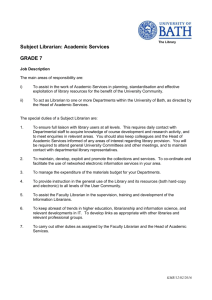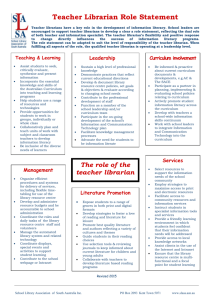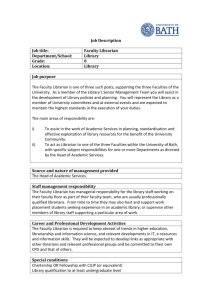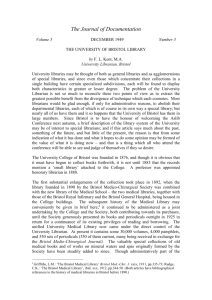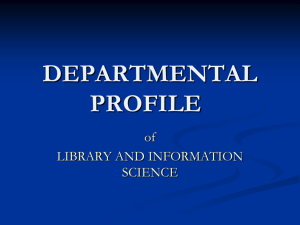Maria Mercer Physics Library
advertisement
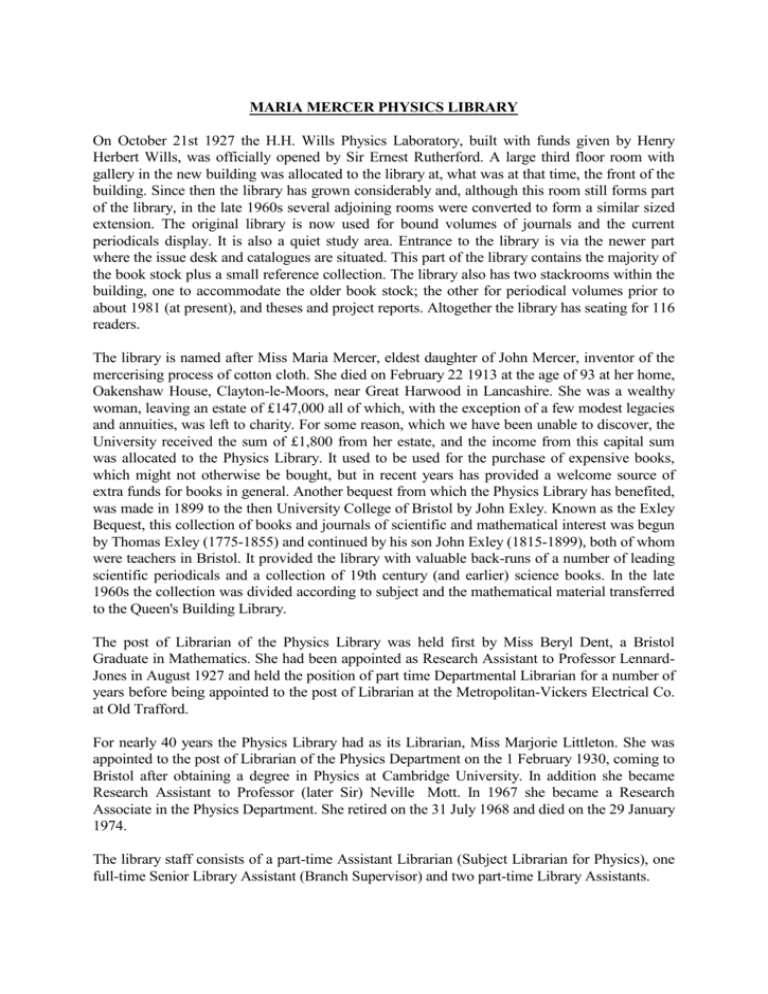
MARIA MERCER PHYSICS LIBRARY On October 21st 1927 the H.H. Wills Physics Laboratory, built with funds given by Henry Herbert Wills, was officially opened by Sir Ernest Rutherford. A large third floor room with gallery in the new building was allocated to the library at, what was at that time, the front of the building. Since then the library has grown considerably and, although this room still forms part of the library, in the late 1960s several adjoining rooms were converted to form a similar sized extension. The original library is now used for bound volumes of journals and the current periodicals display. It is also a quiet study area. Entrance to the library is via the newer part where the issue desk and catalogues are situated. This part of the library contains the majority of the book stock plus a small reference collection. The library also has two stackrooms within the building, one to accommodate the older book stock; the other for periodical volumes prior to about 1981 (at present), and theses and project reports. Altogether the library has seating for 116 readers. The library is named after Miss Maria Mercer, eldest daughter of John Mercer, inventor of the mercerising process of cotton cloth. She died on February 22 1913 at the age of 93 at her home, Oakenshaw House, Clayton-le-Moors, near Great Harwood in Lancashire. She was a wealthy woman, leaving an estate of £147,000 all of which, with the exception of a few modest legacies and annuities, was left to charity. For some reason, which we have been unable to discover, the University received the sum of £1,800 from her estate, and the income from this capital sum was allocated to the Physics Library. It used to be used for the purchase of expensive books, which might not otherwise be bought, but in recent years has provided a welcome source of extra funds for books in general. Another bequest from which the Physics Library has benefited, was made in 1899 to the then University College of Bristol by John Exley. Known as the Exley Bequest, this collection of books and journals of scientific and mathematical interest was begun by Thomas Exley (1775-1855) and continued by his son John Exley (1815-1899), both of whom were teachers in Bristol. It provided the library with valuable back-runs of a number of leading scientific periodicals and a collection of 19th century (and earlier) science books. In the late 1960s the collection was divided according to subject and the mathematical material transferred to the Queen's Building Library. The post of Librarian of the Physics Library was held first by Miss Beryl Dent, a Bristol Graduate in Mathematics. She had been appointed as Research Assistant to Professor LennardJones in August 1927 and held the position of part time Departmental Librarian for a number of years before being appointed to the post of Librarian at the Metropolitan-Vickers Electrical Co. at Old Trafford. For nearly 40 years the Physics Library had as its Librarian, Miss Marjorie Littleton. She was appointed to the post of Librarian of the Physics Department on the 1 February 1930, coming to Bristol after obtaining a degree in Physics at Cambridge University. In addition she became Research Assistant to Professor (later Sir) Neville Mott. In 1967 she became a Research Associate in the Physics Department. She retired on the 31 July 1968 and died on the 29 January 1974. The library staff consists of a part-time Assistant Librarian (Subject Librarian for Physics), one full-time Senior Library Assistant (Branch Supervisor) and two part-time Library Assistants. The Physics Library serves the research and teaching needs of the Physics Department in particular, but is also used by a wide cross-section of other departments in the University, especially Chemistry and Engineering. Not only does the stock cover physics, but also mathematics, astronomy, electronics, geophysics, medical physics and materials science, plus such topics as the history and philosophy of science, science and society and biographical material on scientists. At present we subscribe to approximately 80 current periodical titles in print format and provides access to over 9000 online journals and at the end of 2005/06 the library had a stock of 33,951 volumes. Issues for 2005/06 were 9335 including 2194 short loans (lecture note folders, and Day Book Loans). Books and pamphlets are classified according to the International Classification for Physics adopted by INSPEC for Physics Abstracts and also used by a number of primary journals, including those published by the Institute of Physics and the American Institute of Physics, for the classification of the subject indexes to their journals. The classification is up-dated regularly to cover new topics, is simple and clear when used to label books, and provides a useful link for readers between books and periodicals in the Physics Library. An adaptation of the INSPEC Electrical and Electronics sectional classification has been added to cover topics in electrical engineering and electronics held by the Physics Library. LB/10.8.99 DAG/rev/20.09.2006





